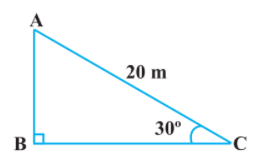सही विकल्प चुनिए और अपने विकल्प की पुष्टि कीजिए
1+tan2A1+cot2A बराबर है :
(A).sec2A
(B).−1
(C).cot2A
(D).tan2A
sec2A
−1
cot2A
tan2A
Step by step video & image solution for सही विकल्प चुनिए और अपने विकल्प की पुष्टि कीजिए (1 + tan^(2) A)/(1 + cot^(2) A) बराबर है :(A).sec^(2) A(B).-1(C).cot^(2) A(D).tan^(2) A by Maths experts to help you in doubts & scoring excellent marks in Class 10 exams.
Updated on:21/07/2023Topper's Solved these Questions
Similar Questions
निम्नलिखित का मान निकालिए :
(i) sin18∘cos72∘ (ii) tan26∘cot64∘ (iii) cos48∘−sin42∘ (iv) cosec 31∘−sec59∘
View Solutionसर्कस का एक कलाकार एक 20m लंबी डोर पर चढ़ रहा है जो अच्छी तरह से तनी हुई है भूमि पर सीधे लगे खंभे के शिखर से बंधा हुआ है। यदि भूमि स्तर से साथ डोर द्वारा बनाया गया कोण 30∘ का हो तो खंभे की ऊँचाई ज्ञात कीजिए (देखिए आकृति)।

View Solutionआकृति 6.56 में PS कोण QPR का समद्विभाजिक है । सिद्ध कीजिए कि QSSR=PQPR है ।

View SolutionThe value of |[a,a+d,a+2d] , [a+d,a+2d,a+3d] , [a+2d,a+3d,a+4d]|+|[b
View SolutionChoose the chain terminating step
(1) H2→H⋅+H⋅
(2) Br2→Br⋅+Br⋅
(3) Br⋅+HBr→H⋅+Br2
(4) H⋅+Br2→HBr+Br⋅
(5) Br⋅+Br⋅→Br2
View SolutionThe name of
 according to IUPAC nomenclature system is :
according to IUPAC nomenclature system is :
View SolutionIn CH_(3)CH_(2)Br,% of Br is
View SolutionIf : f(x)=sec2x, lt br gt then : (1+tanA⋅tanB)2+(tanA−tanB)2=
View SolutionC∣BrH2−C∣BrH2(A)−−→CH≡CH, where A is ,
View SolutionWhich one of the following is more reactive towards SN2 mechanism.
((CH3)3C−Br). ((CH2)3CH−Br). ((CH3)CH2−Br). (CH_3-Br).
View Solution1) Fragmentation () a) Planaria br 2) Unripe fruits () b) Yeast br 3) Desire () c) Spirogyra br 4) Reproduction () d) Watermelon br
View SolutionCan Fe3+ oxidize Br− to Br2 at 1 M concentration ?
E∘(Fe3+∣Fe2+=0.77VandE∘(Br∣Br−)=1.09V
View Solution[" Which alkyl bromide will yield only one alkene upon "E_(2)" elemination? "],[[" 1) "," ( "" Br "," 2) "," Br "" 3) "," Br "," ( "" ) "," ( Br "]]
View Solutionsec^2 A/1+ cot^2 A बराबर है -
View SolutionThe IUPAC name of underset("Br ")underset("| ")("C ")H_(2)-underset("Br ")underset("| ")("C ")H_(2) is ……..
View SolutionIf the bond energies of H-H, Br-Br and HBr are 433,192and364kJmol−1 respectively, then ΔH∘ for the reaction :
H2(g)+Br2(g)→2HBr(g) is
View Solution
